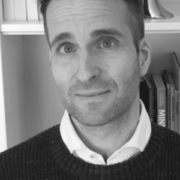Families are travelling as far as five-hours on a round trip to bring their kids with CP to Gympanzees’ all-inclusive pop-up leisure centre.
You might wonder why anyone would travel that far to go to a gym. For these families and their often-isolated children, the wonderful results being seen by this first-of-its-kind program make it a no-brainer.
Reportedly, 84 per cent of UK families with a child with a disability can’t access regular leisure activities. That sort of inactivity then has a knock-on effect for that child’s physical and mental health.
It’s not only the child that is impacted -this kind of societal isolation has an enormous impact on families. Reports suggest that 72 per cent of parents in this situation also experience mental health challenges related to the isolation.
Enter Stephanie Wheen-Gympanzees’ Founder and CEO, and Physiotherapist for children with cerebral palsy.
In 2016, Stephanie began extensive market research and early planning on how to overcome this issue, specifically in the Bristol area.
It was the tipping point for many lives to be uplifted by what was to come.
The project
All that market research led Stephanie to create Gympanzees, a fully inclusive leisure facility which would cater for people from 0 – 25 years of age with any ability.
The centres have many different types of rooms that each offer a unique way of getting active and having a sensory experience, including:
- Sensory rooms
- Music rooms
- Indoor and outdoor playgrounds
- Space for soft play
- Trampolines
- A gym
- Therapy rooms
- Studios for classes such as yoga
Her vision was about creating a safe space for people with disabilities to become fully engaged in play-motivated exercise. She also wanted families to have the support of being able to interact with one another.
“The major goal of Gympanzees is to encourage fitness in young people through play, using highly trained staff who can engage with each visitor using specialised equipment,” says Stephanie.
So, with all that in mind, she pitched her idea for Gympanzees to the Natwest Accelerator program and incorporated as a social enterprise in 2017.
The newly formed social enterprise went on to make plans for building the first permanent Gympanzees facility, but it became quickly apparent that this would not be a fast process.
Not wanting to lose momentum on addressing the need, Gympanzees became a pop-up exercise.
The first four-week Gympanzees pop-up was held at a special school during the UK Summer of 2018, supported by more than 80 volunteers and members of staff.
Every day, close to 56 children came through the pop-up gym.
The following Easter, Gympanzees held their second pop-up which saw tremendous growth with close to 80 children coming through the daily.
“We’re running pop-ups in school holidays because we know that’s a time when the families of children with disabilities feel isolated,” says Stephanie.
Alongside the pop-up gyms, Gympanzees has also grown a thriving online community, with social media being used to make sure people know when and where all the action is taking place. It’s also creating a place for families to communicate outside of the pop-up events.
The results
To-date, more than 527 people with CP have visited one of Gympanzees’ three pop-ups, and more than 3930 people have visited in total.
“Our research tells us that 98 per cent of those people loved their experience and would come again,” says Stephanie.
“Every parent tells us we offer unique facilities for them and their child that can’t be found elsewhere,” she says.
Approximately one in five visitors to a Gympanzees pop-up will travel for over two-hours for the experience.
“Several of our visitors spend close to a five-hour round trip just for one session,” says Stephanie.
“This tells me how desperate the need is for our service.”
To evidence the need and the results, three interns from the University of Bristol have joined with Stephanie purely to conduct research on the Gympanzees facilities and the impact it’s having on those it’s intended to help.
A subsequent report has been produced by the interns which lends great credence to the achievements of Gympanzees.
The report incorporates a substantial element of feedback on experiences had by those attending the pop-ups and has become a central feature of how Stephanie and the Gympanzees crew continue to evolve what they do.
“Our visitors have experienced countless health benefits, including drastic improvements to sleep patterns, new strengths, confidence in walking and in their other gross motor skills,” Stephanie explains.
Among the success stories coming from the early days of Gympanzees is that of a six year old who managed to take five steps on her own using her frame. Prior to this, her mum would move her legs for her, so this shows the scale of the progress made at the pop-up.
Another six year old boy learnt to hold his head up for the first time and was able to do so for a full 10-minutes.
“A particularly special moment for Gympanzees was with a man living with CP who joined his 3-year old son on a trampoline for the first time with the aid of hoists,” says Stephanie.
“The son had no disability and so this showed us the effect on the quality of life for our beneficiaries. It’s so obvious in the smiles and the strengths we see develop in our facilities.
“Particularly special was seeing a three year old boy laugh for the first time while using our equipment with his mum. She said it was the best moment in the last three years of her life.
“Our ethos and focus is on fun,” says Stephanie who shares the quote below which came from one parent that she feels tells the whole story:
“There is a difference between your child being tolerated and celebrated, and here it is so clear they are celebrated.”
It’s not just the people who use the gym facilities at Gympanzees that are benefiting from this initiative either.
The well-run café that supports the Gympanzees pop-ups is staffed by a volunteer adult with CP and his carer.
“It’s another great testament to our inclusivity, demonstrating how people with disabilities are central to the delivery of our project,” Stephanie shares.
Future plans
Right now, Stephanie is most focused on proving that the Gympanzees pop-ups can generate the minimum number of attendees each month to deliver financial sustainability for a permanent bricks and mortar facility.
“Each of our pop-ups grows incrementally, requiring more rooms and equipment, larger rooms and longer hours,” she says.
“We are planning to continue our pop-ups and building our supporter base, business model and offering the much-needed services.”
The hope is to secure funding and land for a permanent Gympanzees leisure centre to be built by 2022, with a long-term vision to open 13 such centres across the UK.
“On weekdays the facility will be used for regular play as well as therapy sessions, and on weekends, the studios will be available for birthday parties or other celebrations,” says Stephanie.
“It will be a social space for people to meet up, get to know and support each other.”
An online shop is also in planning so parents can purchase the equipment their children are using at Gympanzees and enjoy continuing development at home.
Stephanie has already been approached by other therapy centres and interested parties from across the UK who are interested in the Gympanzees model. This has led to investigations around the possibility of franchising the pop-ups with the aim of testing the concept in areas outside Bristol before building further bricks and mortar centres.
Gympanzees won the Major Award for Quality of Life in the 2019 World Cerebral Palsy Day Awards.
To learn more, visit gympanzees.org
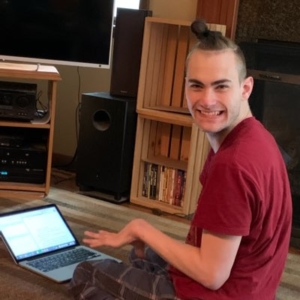 “I was introduced to a head pointer by my occupational therapist at around 10 years old, but the metal gave me a headache after a while. Then I used my nose one day and realised I was more in control and more efficient. From then on I used my nose,” shared Kevin.
“I was introduced to a head pointer by my occupational therapist at around 10 years old, but the metal gave me a headache after a while. Then I used my nose one day and realised I was more in control and more efficient. From then on I used my nose,” shared Kevin.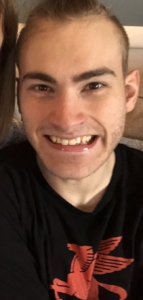 “Don’t be afraid to try things, sometimes it may just need to be modified and other times it just cannot happen and it’s okay to accept that. God has a purpose for all of us. There is no perfect and there is no normal. We are all special,” Kevin finished.
“Don’t be afraid to try things, sometimes it may just need to be modified and other times it just cannot happen and it’s okay to accept that. God has a purpose for all of us. There is no perfect and there is no normal. We are all special,” Kevin finished.
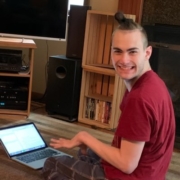
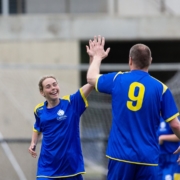
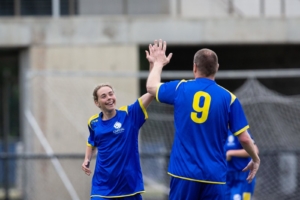 Matilda, who works in IT for the National Disability Insurance Agency, is part of the
Matilda, who works in IT for the National Disability Insurance Agency, is part of the 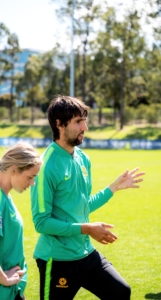 Matilda knows the value of mentoring, and has been mentoring for many years now.
Matilda knows the value of mentoring, and has been mentoring for many years now.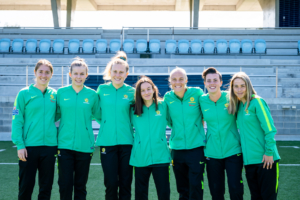 As a mentor, Matilda’s goal is to show others that people with disabilities are capable of achieving anything they put their mind to, and that when the going gets tough, she’ll be there to catch her mentees and pick them up.
As a mentor, Matilda’s goal is to show others that people with disabilities are capable of achieving anything they put their mind to, and that when the going gets tough, she’ll be there to catch her mentees and pick them up.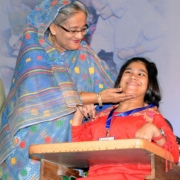
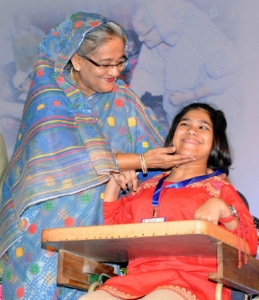
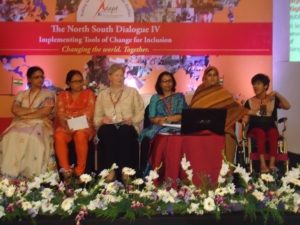 After a couple of years of regular schooling when she became eligible to sit for O and A Level exams, she faced tremendous problems. For example, British Council provided her a scribe of different background and as a consequence she had to face difficulties in communication during her exam. So, her knowledge did not reflect in her results, though she had been working very hard. She expresses her frustration – “I attended the school regularly but I can’t write and stand. Many times at school people can’t understand me. I have a woman who writes for me but often she doesn’t understand and I have to spell out the words.
After a couple of years of regular schooling when she became eligible to sit for O and A Level exams, she faced tremendous problems. For example, British Council provided her a scribe of different background and as a consequence she had to face difficulties in communication during her exam. So, her knowledge did not reflect in her results, though she had been working very hard. She expresses her frustration – “I attended the school regularly but I can’t write and stand. Many times at school people can’t understand me. I have a woman who writes for me but often she doesn’t understand and I have to spell out the words.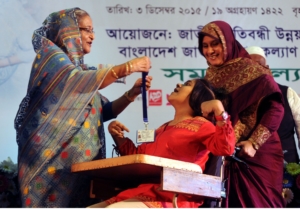 In 2012 at the age of 14 she attended an international conference on disability in Goa, India. 200 delegates from different parts of the world joined the conference and she was the youngest participant. Comments made by the organizers on her speech reads – “The person who stole the show on the third day is also the youngest delegate in the conference – 14 year old Anila from Bangladesh. Holding the audience in rapt attention for 10 minutes, this spunky girl who has cerebral palsy said in slow but intelligible English, ‘It is painful when I go to the market and people stare. I am not included in schools. I have seen my mother cry so many times due to this.’ The young age has not come into the way of her asserting her fundamental rights as she has been instrumental in bringing disability into the purview of the globally reputed organization ‘Save The Children’.
In 2012 at the age of 14 she attended an international conference on disability in Goa, India. 200 delegates from different parts of the world joined the conference and she was the youngest participant. Comments made by the organizers on her speech reads – “The person who stole the show on the third day is also the youngest delegate in the conference – 14 year old Anila from Bangladesh. Holding the audience in rapt attention for 10 minutes, this spunky girl who has cerebral palsy said in slow but intelligible English, ‘It is painful when I go to the market and people stare. I am not included in schools. I have seen my mother cry so many times due to this.’ The young age has not come into the way of her asserting her fundamental rights as she has been instrumental in bringing disability into the purview of the globally reputed organization ‘Save The Children’.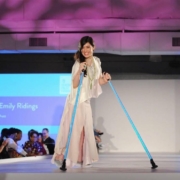
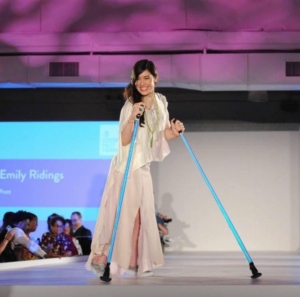 Xian’s cerebral palsy manifests in muscle tension, muscle weakness, poor balance and coordination and dragging her left foot. She walks with adapted two ski poles for balance, which she says she occasionally dresses up to compliment an outfit, for example, black Satin for prom.
Xian’s cerebral palsy manifests in muscle tension, muscle weakness, poor balance and coordination and dragging her left foot. She walks with adapted two ski poles for balance, which she says she occasionally dresses up to compliment an outfit, for example, black Satin for prom.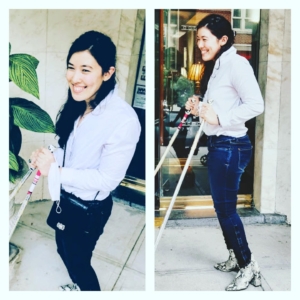 Xian says that her whole life she’s paid attention to brands that had sturdier soles, like the Merrell branded shoes she wore in different colours for five years straight.
Xian says that her whole life she’s paid attention to brands that had sturdier soles, like the Merrell branded shoes she wore in different colours for five years straight.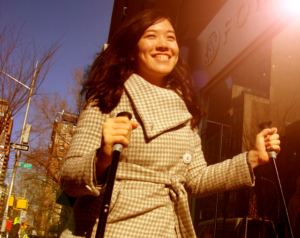 According to Xian, best practice in fashion design is facilitating ease of wear, considering as many unique bodies as possible, and making designs both accessible and beautiful.
According to Xian, best practice in fashion design is facilitating ease of wear, considering as many unique bodies as possible, and making designs both accessible and beautiful.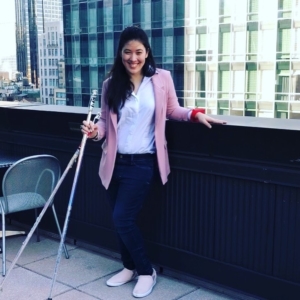 “Typically, I like clothes that are flowy and a bit bohemian. So most days, I would have said [my favourite clothes are] maxi dresses, jumpsuits (purely aesthetic in this case, for my long body type, but still often inaccessible so I need help getting out of them) or tunics, but since walking in NY fashion week in Sept, my new favourite outfit is the professional wear Zappos sent me. This includes the amazing
“Typically, I like clothes that are flowy and a bit bohemian. So most days, I would have said [my favourite clothes are] maxi dresses, jumpsuits (purely aesthetic in this case, for my long body type, but still often inaccessible so I need help getting out of them) or tunics, but since walking in NY fashion week in Sept, my new favourite outfit is the professional wear Zappos sent me. This includes the amazing 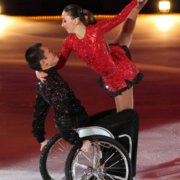
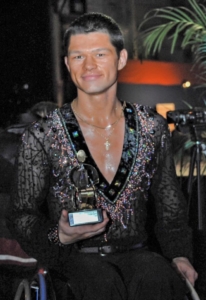 Twenty-nine year old Maxim Kiselev lives in in Moscow, Russia, with his beautiful fiancé, Natalia, and lives with spastic tetraplegia which mainly affects the left side of his body. Maxim is a wheelchair dancer, and does both ballroom style dancing and figure skating on ice.
Twenty-nine year old Maxim Kiselev lives in in Moscow, Russia, with his beautiful fiancé, Natalia, and lives with spastic tetraplegia which mainly affects the left side of his body. Maxim is a wheelchair dancer, and does both ballroom style dancing and figure skating on ice.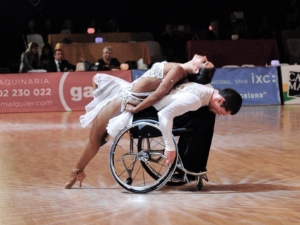 While his start in partner dancing was good, he says finding the right partner (or any partner!) wasn’t easy, and he faced a lot of discrimination along the way.
While his start in partner dancing was good, he says finding the right partner (or any partner!) wasn’t easy, and he faced a lot of discrimination along the way.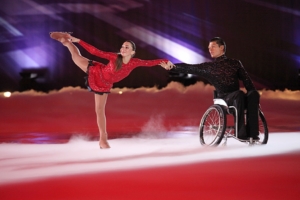
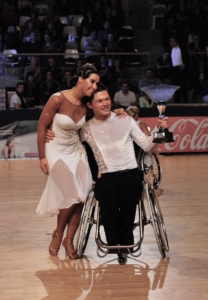 While Maxim’s dance skills grew to be exceptional, partner dancing with one standing and one seated dancer could be quite tricky!
While Maxim’s dance skills grew to be exceptional, partner dancing with one standing and one seated dancer could be quite tricky!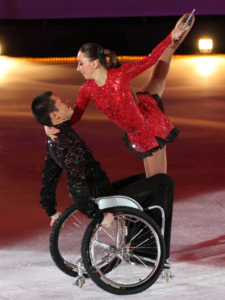
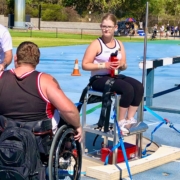
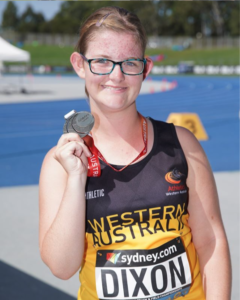 In 2014 I was a part of a research program at the
In 2014 I was a part of a research program at the 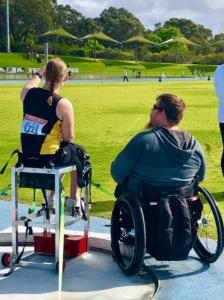 Mark asked me to get a
Mark asked me to get a 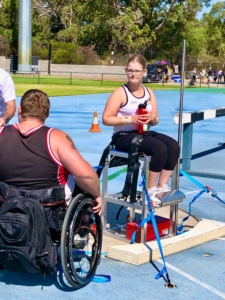 For most para sports each athlete has to have a classification, which is a number that represents your disability. I’m going to give athletics for an example – T/F21 classification is suited for everyone that has down syndrome, some of you may not know this as this is the newest classification in athletics. If you are competing against other para-athletes and from other classifications. Once your event has finished an official will take it away to get marked, and whoever wins has the highest percentage. This percentage is out of the world record. I don’t know about other sports, but for athletics, this is done this way to give para-athletes a fair advantage.
For most para sports each athlete has to have a classification, which is a number that represents your disability. I’m going to give athletics for an example – T/F21 classification is suited for everyone that has down syndrome, some of you may not know this as this is the newest classification in athletics. If you are competing against other para-athletes and from other classifications. Once your event has finished an official will take it away to get marked, and whoever wins has the highest percentage. This percentage is out of the world record. I don’t know about other sports, but for athletics, this is done this way to give para-athletes a fair advantage.

